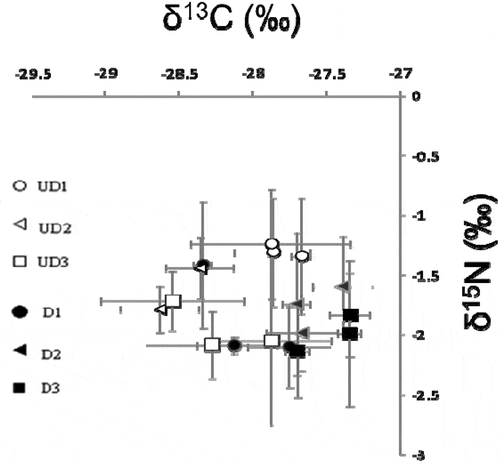 ?Mathematical formulae have been encoded as MathML and are displayed in this HTML version using MathJax in order to improve their display. Uncheck the box to turn MathJax off. This feature requires Javascript. Click on a formula to zoom.
?Mathematical formulae have been encoded as MathML and are displayed in this HTML version using MathJax in order to improve their display. Uncheck the box to turn MathJax off. This feature requires Javascript. Click on a formula to zoom.ABSTRACT
Ozegahara Mire is the largest alpine mire in Japan, and it has been preserved as the precious peatland ecosystem under oligotrophic condition. However, after the late 20 century, the mire has been exposed to ecosystem disturbance by invaded Sika deer. Browsing and digging of the mire vegetation by Sika deer have given considerable impacts on not only vegetation but also biochemical property of the peat soil, resulting in the changes in microbiological activities and nutrient dynamics. However, little information has been provided about the effect of deer disturbance on nitrogen (N) dynamics in the mire. This study aims to provide information about the effects of deer disturbance on nitrogen dynamic including N2 fixation and denitrification in Ozegahara Mire. Soil samples were collected at 6 plots on 2 sites with and without mire disturbance by Sika deer at eastern Naka-Tashiro of Ozegahara mire in July 2018. Mineral N contents and other physicochemical properties of the soil samples were measured. N2 fixation and denitrification activities of the soil samples were also measured at different incubation temperatures (15, 20 or 25°C) under either aerobic or anaerobic conditions by acetylene reduction activity (ARA) and inhibition methods, respectively. As results, the ARA in the disturbed sites were lower than those in the undisturbed sites and also lower under aerobic condition than anaerobic condition. Negative correlation was found between ARA and ammonium N in the soil (R2 = 0.353, p< 0.05), suggesting that mechanical disturbance of the peat soils by deer enhanced mineralization of organic N to suppress N2 fixation. ARA was increased by elevated incubation temperature in the undisturbed sites, while no change in the disturbed sites. Denitrification activities was not affected by the disturbance by Sika deer, while higher under aerobic condition than in anaerobic condition, and in higher temperature than lower temperature. Multi-regression analysis of ARA affecting factors revealed that ARA was significantly influenced by temperature, ammonium N and disturbance. These results indicate the marked influences of the mire disturbance by Sika deer on N2 fixation and denitrification activities of the peat soils and N dynamics in Ozegahara Mire.
1. Introduction
Ozegahara Mire is the largest alpine mire in Honshu (main island of Japan). This mire is located about 1400 m above sea level in the boundary of Gunma, Fukushima, and Niigata Prefectures, surrounded by mountains. The mire has been preserved as the precious peatland ecosystem under oligotrophic condition with high ecological diversity. This area was designed as a national park in 1953. It was also selected as a precious wetland by the Ramsar Convention in 2005 (Igarashi and Takatsuki Citation2008). In Ozegahara Mire, Scientific Research Campaigns were conducted almost every 20 years, and it was found in 4th Scientific Research Campaign that flooding increased input of available phosphorus to some area in Ozegahara due to heavy rain more frequently happen recently, resulting increase densities of N2-fixing plants (Myrica gale var. tomentotosa) (Shigeta et al. Citation2021). Under oligotrophic conditions like in Ozegahara, N2 fixation is important nitrogen input to support vegetation and ecosystem (Shigeta et al. Citation2021). It is considered that, in flood prone area along the streams in Ozegahara, sediments carried by flooding water may supply significant amount of nutrients, while other area with less flooding, N2-fixation by symbiotic N2-fixing plants such as M. gale with N2-fixating actinomyces and free-living microorganisms have significant role in N input from the atmosphere.
It has been discovered that Sika deer (Cervus nippon) started to invade Ozegahara in the 1990s (Naito and Kimura Citation1998). Bimonthly individual numbers of Sika deer crossing light sensing area in Ozegahara increased from about 50 in 2004 to more than 180 in 2019 (Figure S1; Ministry of Environment Citation2020). One of the reasons for increasing Sika deer is attributed to global warming (IPCC Citation2013) that makes their survivals possible over winter (Ministry of Environment Citation2020). Sika deer is potentially dangerous to such habitats because as their density and activities are increasing, and they can greatly affect plant communities. Sika deer in Ozegahara browse and dig in wetland to eat Menyanthes trifoliata rhizomes, and males of Sika deer which are in estrus dig up and rub against ground (Takatsuki Citation1989; Igarashi and Takatsuki Citation2008). It is known that browsing pressure by Sika deer have given considerable impacts on physicochemical properties of peat soil and vegetation (Pellerin, Huot, and Côté Citation2006: Takatsuki Citation2003). However, little information has been provided about the effect of deer disturbance on soil physicochemical and biological properties and nitrogen dynamics including N2-fixing activity and denitrification activity in the mire. N is essential element for plant, so N dynamics, especially N2-fixation and denitrification, and temperature sensitivities are important to preserve precious peatland ecosystem under oligotrophic condition, especially assessing impact of deer disturbance. This study aims at providing information about the effects of Sika deer disturbance on physicochemical and biological properties of the peat soils and the N dynamics in the Ozegahara Mire.
2. Materials and methods
We investigated physicochemical and biological properties of peat soil sample made mainly of Sphagnum materials taken from Ozegahara in Nikko National Park. Mean annual air temperature is 4.6°C and during the time of investigation season (June–September) was 12–18°C (Sakaguchi and Sohma Citation1982). We collected at 6 plots in 2 sites (A and B, with about 20 m distance) with (D1, D2, D3) or without (UD1, UD2, UD3) mire disturbance by Sika deer (3 replicates each) at eastern Naka-Tashiro area (36°55–57ʹN 139°12–15ʹE) of the Ozegahara mire. Disturbed sites are so-called nutaba in Japanese (Figure S2), but it is shown as ‘D’ in brown circles in Figures S3 and S4.
Soil samples (0–10 cm) were taken as 3 cores from each site with a trowel, brought back to the university laboratory in a cooler box to measure their physicochemical and biological properties. Moisture content, soil pH and EC (electric conductivity) were measured by gravimetric and electrode methods (TOA, CM-31P), respectively. The concentrations of ammonium and nitrate-N were measured in 1 M KCl extract by using the nitroprusside method (Anderson and Ingram Citation1989) and hydrazine reduction-naphthyl ethylene diamine method (Hayashi, Sakamoto, and Yoshida Citation1997), respectively.
The stable isotopic compositions of carbon (δ13C) and nitrogen (δ15N) of soil organic matter were determined using an isotope-ratio mass spectrometer (IRMS) connected to an elemental analyzer (Integra-CN, PDZ Europa, UK; Inubushi et al. Citation2020).
Soil acetylene reduction activity (ARA) was measured by ARA as C2H4 quantified with gas chromatograph (Shimadzu, GC-14B) equipped with a flame ionization detector (FID), and denitrification activity by acetylene block methods as N2O quantified with another GC with an electron capture detector (ECD), respectively, both incubated at different incubation temperatures (15, 20 or 25°C) under either aerobic or anaerobic conditions (Japanese Society of Soil Microbiology Citation1992).
Statistical analysis was conducted to see the influence of environmental factors on soil anaerobic ARA by linear-regression analysis correlated with soil mineral N using Excel (Microsoft Office Professional Plus 2013) and multi-regression using CRAN R ver. 3.5.1 (R Core Team, Okada Citation2010), according to the formulae below.
where Y indicates soil anaerobic ARA for dependent variable, while F1 as incubate temperature, F2 as soil ammonium N, F3 as soil nitrate N, and F4 as disturbance for explained variables, and α0 to α4 as factors, respectively.
3. Results
Soil moistures were basically high and pH low, similar as typical wetland (Inubushi et al. Citation2005), and both tended to be higher in the disturbed sites than in the undisturbed sites. Ammonium N was also higher in the disturbed sites, while no significant difference was found for soil EC and nitrate N contents ().
Figure 1. (a) Soil moisture (%), (b) pH (left) and EC (right; mS m−1) and (c) mineral N (upper: nitrate, lower: ammonium, mg N kg−1 wet soil) contents in disturbed (D) and undisturbed (UD) sites.
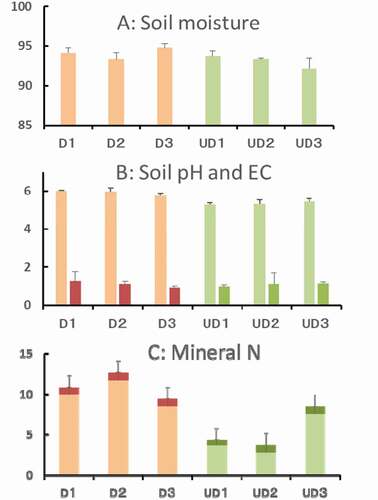
The ARA in the disturbed sites were lower than those in the undisturbed sites and also lower under aerobic condition than anaerobic condition (). Negative correlation was found between ARA and ammonium N in the soil (R2 = 0.353, p< 0.05, ). ARA was increased by elevated incubation temperature in the undisturbed sites, while no significant difference in the disturbed sites in three temperatures.
Figure 2. ARA of disturbed (D) and undisturbed (UD) soils under aerobic (upper) or anaerobic (lower) conditions with different temperatures.
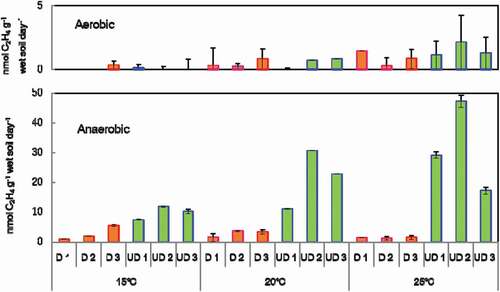
Figure 3. Correlation between ARA and ammonium N of disturbed (D) and undisturbed (UD) soils with different temperatures.
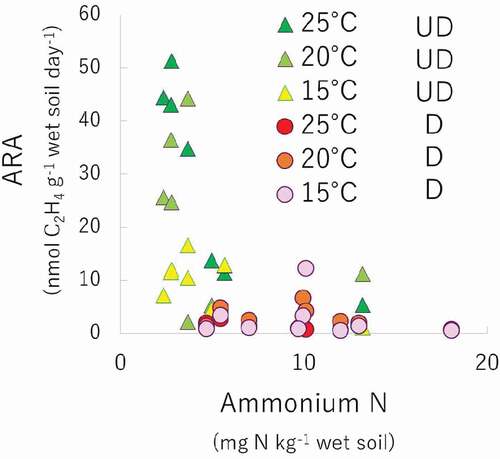
Denitrification activities was higher under aerobic condition than in anaerobic condition, while not affected by the disturbance by Sika deer, and mostly higher in higher temperature than in lower temperature (). Stable isotope ratios of soil organic C and N were not significantly different between disturbed and undisturbed sites ().
Figure 4. Denitrification activities of disturbed (D) and undisturbed (UD) soils under aerobic (upper) or anaerobic (lower) conditions with different temperatures.
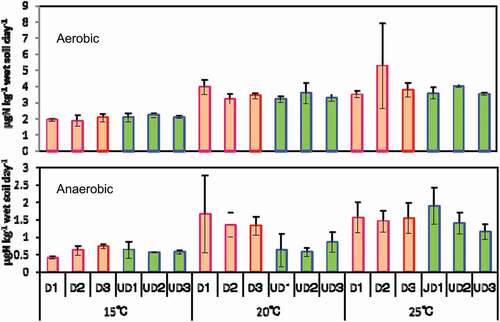
Temperature sensitivity, Q10 (increase ratios of the activities from 15 to 25°C), for ARA under anaerobic conditions was 0.88 ± 0.72 and 3.21 ± 1.32 (mean ± standard deviation) in disturbed and undisturbed sites, respectively, while 1.75–2.76 for denitrification activities without significant influence of disturbance ().
Table 1. Q10 (25/15°C) of ARA and denitrification activities of disturbed (D) and undisturbed (UD) soils under aerobic or anaerobic conditions
Multi-regression analysis of ARA indicated that main affecting factors were the disturbance, ammonium N and temperatures, in this order for the pooled values in the disturbed and undisturbed sites using formula (1), and also significantly affected by ammonium N in the undisturbed site, while no significance was found in the disturbed site using formula (2) ().
Table 2. Multi-regression analysis of affecting factors for anaerobic ARA in disturbed (D) and undisturbed (UD) soils
4. Discussion
In the undisturbed natural area, such N2 fixation can be maintained, while in the disturbed area by Sika deer, N2 fixation may be suppressed by increase of ammonium N derived from decomposition of physically damaged peat materials.
After Sika deer disturbance, it has reported that peat soil temperature increased due to direct sun light (Furusawa et al. Citation2006), so temperature sensitive denitrification may also be enhanced, while N2-fixation in disturbed area is keep suppressed (), inducing changes in N dynamics and cause ecosystem disturbances. Lee, Suzuki, and Inubushi (Citation2018) also reported that carbon decomposition is depend on in-situ temperature, resulting differences in CO2 and CH4 emission rates from brackish marsh in northern Honshu Island, Japan. These reports support that Sika beer disturbance also enhance organic matter decomposition by rising soil temperature and then affected also N dynamics in Ozegahara.
Yoh and Tsuruta (Citation1998) reported that anaerobic ARA was 1 magnitude higher than aerobic ARA which was similar as our results, and had peaked at about 17 cm deep peat profile in Shimo-Tashiro, Ozegahara. Multi-regression analysis of anaerobic ARA showed that ammonium N and the Sika deer disturbance had strongest impacts to suppress the N2-fixation activity.
Relatively higher δ13C and lower δ15N values were found for disturbed samples than undisturbed samples (). Akagi and Osawa (Citation2004) reported that sundew samples along wooden walkway tended to be higher δ13C and lower δ15N values than peat moss samples in Ozegahara, which indicated higher human (visitor) s’ impact on natural vegetation even in strictly protected environment like national park. Although no significance in δ15N values, lower values in disturbed sites suggested that effect of Sika deer disturbance might be caused by suppression of N2 fixation, however still limited data in short term and surface soil layers to consider N dynamics. Longer and more detail investigation is necessary.
In conclusion, these results suggested that mechanical disturbance of the peat soils by Sika deer enhanced mineralization of organic N to suppress N2 fixation. These results indicate the marked influences of the mire disturbance by Sika deer on N2 fixation and denitrification activities of the peat soils and N dynamics in Ozegahara Mire.
Supplemental Material
Download MS Word (4.5 MB)Disclosure statement
No potential conflict of interest was reported by the author(s).
Supplementary material
Supplemental data for this article can be accessed here.
Additional information
Funding
References
- Akagi, T., and K. Osawa. 2004. “Possible Input of Nitrogen of Visitors’ Origin on a Protected Peatland.” Environmental Management 35 (4): 461–467. doi:https://doi.org/10.1007/s00267-003-0103-5.
- Anderson, J. M., and J. S. I. Ingram. 1989. “Colorimetric Determination of Ammonium.” In Tropical Soil Biology and Fertility, edited by ISSS, 42–43. Wallingford: CAB International.
- Furusawa, H., T. Hino, S. Kaneko, and M. Araki. 2006. “Effects of Sika Deer (Cervus Nippon) and Sasa Nipponica on the Temperature and Moisture of the Surface Soil in Odaigahara.” Japanese Journal of Forest Environment 48 (2): 91–98. (in Japanese).
- Hayashi, A., K. Sakamoto, and T. Yoshida. 1997. “A Rapid Method for Determination of Nitrate in Soil by Hydrazine Reduction Procedure.” Japanese Journal of Soil Science and Plant Nutrition 68 (3): 322–326. (in Japanese with English summary).
- Igarashi, T., and S. Takatsuki. 2008. “Effects of Defoliation a Digging Caused by Sika Deer in the Oze Mires of Central Japan.” Biosphere Conservation 9 (1): 9–16. doi:https://doi.org/10.20798/biospherecons.9.1_9.
- Inubushi, K., S. Otake, Y. Furukawa, N. Shibasaki, M. Ali, A. M. Itang, and H. Tsuruta. 2005. “Factors Influencing Methane Emission from Peat Soils: Comparison of Tropical and Temperate Wetlands.” Nutrient Cycling on Agroecosystems 71 (1): 93–99. https://doi.org/https://doi.org/10.1007/s10705-004-5283-8
- Inubushi, K., M. Yashima, S. Hanazawa, A. Goto, K. Miyamoto, T. Tsuboi, and G. Asea. 2020. “Long-term Fertilizer Management in NERICA Cultivated Upland Affects on Soil Bio-chemical Properties.” Soil Science and Plant Nutrition 66 (1): 247–253. doi:https://doi.org/10.1080/00380768.2019.1705738.
- IPCC. 2013. Climate Change 2013: The Physical Science Basis. Contribution of Working Group 1 to the Fifth Assessment Report of Intergovernmental Panel on Climate Change. Cambridge, United Kingdom and New York, NY, USA: Cambridge University Press.
- Japanese Society of Soil Microbiology. 1992. New Experimental Methods in Soil Microbiology. Tokyo: Yokendo.
- Lee, C. G., S. Suzuki, and K. Inubushi. 2018. “Temperature Sensitivity of Anaerobic Labile Soil Organic Carbon Decomposition in Brackish Marsh.” Soil Science and Plant Nutrition 64 (4): 443–448. doi:https://doi.org/10.1080/00380768.2018.1464374.
- Ministry of Environment. 2020. “Sika Deer Countermeasure Meeting in Oze Nikko National Park.” Discussion Paper in 2nd Meeting.
- Naito, T., and Y. Kimura. 1998. “Sika Deer in the Oze Area.” In A Comprehensive Study of the Oze, edited by Y. Oshima, 725–739. Maebashi, Japan: Research Commission of Academic ad Comprehensive Study of the Oze Area. In Japanese.
- Okada, Y. 2010. “Pass Analysis.” http://cogpsy.educ.kyoto-u.ac.jp/personal/Kusumi/datasem10/okada.pdf
- Pellerin, S., J. Huot, and S. D. Côté. 2006. “Long-term Effects of Deer Browsing and Trampling on the Vegetation of Peatlands.” Biological Conservation 128 (3): 316–326. doi:https://doi.org/10.1016/j.biocon.2005.09.039.
- Sakaguchi, Y., and H. Sohma. 1982. “Characteristics of Bank and Hollow Complexes in the Ozegahara Moor.” In Ozegahara: Scientific Research of the Highmoor in Central Japan, edited by H. Hara, S. Asahina, Y. Sakaguchi, K. Hogetsu, and N. Yamagata, 31–46, Maebashi: Oze Investigation Team.
- Shigeta, H., K. Nakayama, M. Yashima, K. Inubushi, and M. Sakamoto. 2021. “Physicochemical Characteristics and Nitrogen Metabolisms of the Peat Soil System in Ozegahara under Impacts of Flooding.” Japanese Journal of Limnology. (in Japanese with English abstract).
- Takatsuki, S. 1989. “Effects of Deer on Plants and Plant Communities.” Japanese Journal of Ecology 39: 67–80. in Japanese with English abstract.
- Takatsuki, S. 2003. “Use of Mires and Food Habits of Sika Deer in the Oze Area, Central Japan.” Ecological Research 18 (3): 331–338. doi:https://doi.org/10.1046/j.1440-1703.2003.00558.x.
- Yoh, M., and H. Tsuruta. 1998. “Anaerobic Nitrogen Fixation.” In A Comprehensive Study of the Oze, edited by Y. Oshima, 230–243. Maebashi, Japan: Research Commission of Academic ad Comprehensive Study of the Oze Area. (in Japanese).

